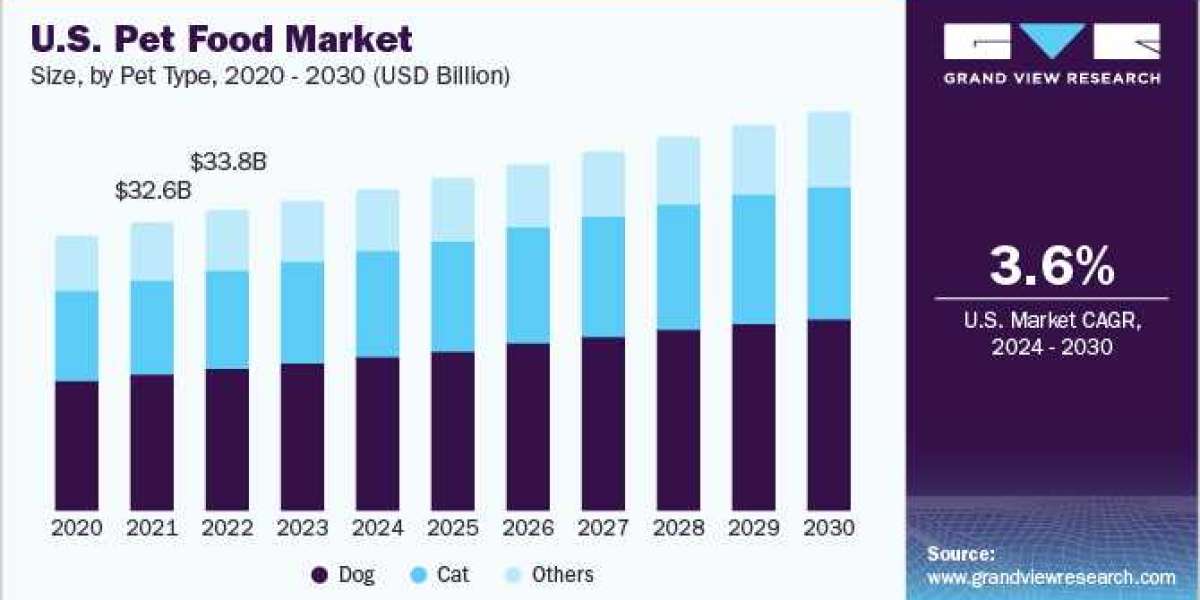Pet Food Industry Overview
The global pet food market size was estimated at USD 103.3 billion in 2023 and is expected to grow at a compound annual growth rate (CAGR) of 4.4% from 2024 to 2030.
The demand for products is anticipated to be driven by growing consumer inclination toward the adoption of pets along with rising concerns regarding their health. Improvement in overall digestion and performance of pet animals owing to consumption of nutritious food is also likely to boost market growth in the forecast period. The pet food products that are available in the global market rarely vary. This, in turn, has prompted manufacturers to include multi-functional and innovative ingredients in their products to curb such similarity bias. Convenience is likely to play a vital role in driving this industry, given the increased popularity of prepared pet food. The other segment is organic pet food, a recent and growing trend in the market.
Gather more insights about the market drivers, restrains and growth of the Pet Food Market
Increasing availability of organic products in a variety of flavors and the inclusion of essential ingredients such as probiotics and antioxidants are factors that are likely to induce a positive impact on global market growth. On the other hand, low product penetration owing to its slightly high price may restrain organic segment growth in the coming years as every household would not be able to purchase high-priced products.
The market value chain is characterized by the presence of raw material suppliers, manufacturers, distributors, and end-users. The raw materials which are used for production include meat, meat byproducts, cereals, grains, and specialty proteins derived from animals, palatants, flavors sweeteners, vitamins, minerals, and enzymes among others.
Manufacturers formulate these products in accordance with the standard nutritional requirements of domesticated animals. Meat-based raw materials are processed/rendered to separate protein components, water, and fat. The manufacturing process also entails grinding, cooking, and mixing the aforementioned raw materials with other ingredients.
The raw materials utilized in each pet food product segment are primarily commodities and agricultural-based products. Grains, fruits, and animal protein meals, among other ingredients, are procured from various suppliers. The cost, quality, and availability of these key ingredients have fluctuated in the past and are expected to fluctuate in the future as well. For instance, in March 2023, pet food prices in America rose by 15.1% YoY. Due to this, residents are considering giving away their pets. Such sudden and sharp increases in the prices of pet food can adversely affect market growth.
Browse through Grand View Research's Consumer FB Industry Research Reports.
- The global frozen bakery market size was estimated at USD 67.27 billion in 2023 and is projected to grow at a CAGR of 5.2% from 2024 to 2030.
- The global organic rice protein market size was valued at USD 69.5 billion in 2023 and is projected to grow at a CAGR of 12.9% from 2024 to 2030.
Global Pet Food Market Report Segmentation
This report forecasts volume revenue growth at global, regional, and country levels and provides an analysis of the latest industry trends in each of the sub-segments from 2018 to 2030. For this study, Grand View Research has segmented the global pet food market report based on pet type and region:
Pet Type Outlook (Revenue, USD Million; Volume, Kilotons; 2018 - 2030)
- Dog
- Wet Food
- Dry Food
- Snacks/Treats
- Cat
- Wet Food
- Dry Food
- Snacks/Treats
- Others
Regional Outlook (Revenue, USD Million; Volume, Kilotons; 2018 - 2030)
- North America
- US
- Canada
- Mexico
- Europe
- Germany
- UK
- France
- Italy
- Spain
- Poland
- Ukraine
- Russia
- Turkey
- Asia Pacific
- China
- India
- Japan
- South Korea
- Indonesia
- Malaysia
- Vietnam
- Thailand
- Australia
- Central South America
- Brazil
- Argentina
- Middle East Africa
- Middle East
- South Africa
Key Companies Market Share Insights
The competitive landscape of this market is moderately consolidated with the presence of multinationals striving to fulfill high demand from large customers and end-user base. Key industry participants are inclined toward adopting new marketing strategies and using advanced technologies to strengthen their customer base and generate more revenue in near future. In addition, companies are undertaking expansion, mergers, and acquisitions as a part of their strategic initiatives. For example, in January 2022, Manna Pro acquired Oxbow Animal Health, a small animal pet brand that offers premium food, and supplements for rabbits, pigs, hamsters, and other pets. In addition, in September 2023, Superlatus, Inc., a key food distribution and technology firm, merged with TRxADE HEALTH, Inc., and announced its expansion in the pet food industry with plant-based or vegan pet food treats.
Industry participants are inclined toward investing heavily in research and technology to advance processes and create new recipes, which are manufactured with varied and special ingredients. Key manufacturers are also focused on developing innovative formulas to offer diverse and high-quality food for pets and farm animals. Industry players also utilize raw materials with criteria to meet demands, as well as regulations, in both domestic and international markets.
Key Pet Food Companies:
- The J.M. Smucker Company
- Nestle Purina
- Mars, Incorporated
- LUPUS Alimentos
- Total Alimentos
- Hill’s Pet Nutrition, Inc.
- General Mills Inc.
- WellPet LLC
- The Hartz Mountain Corporation
Order a free sample PDF of the Pet Food Market Intelligence Study, published by Grand View Research.


